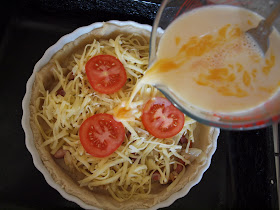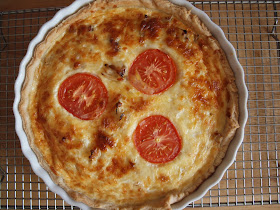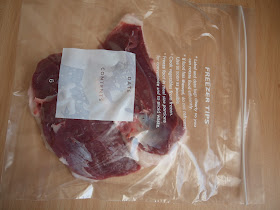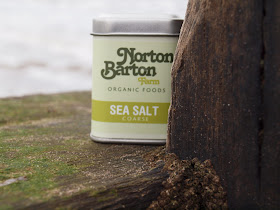 What could you make with these 3 ingredients?
What could you make with these 3 ingredients?Thursday, 28 October 2010
Feeling Bored !
Are you feeling bored this morning? Then consider food art during todays vegetable prep and bring a smile to your colleagues!
 What could you make with these 3 ingredients?
What could you make with these 3 ingredients?
 What could you make with these 3 ingredients?
What could you make with these 3 ingredients?Tuesday, 26 October 2010
Quiche Lorraine
Quiche Lorraine or Egg & Bacon Flan, whatever you call this homemade dish, it is sure to please, either served cold on a summers day buffet or warm on a winters day at lunchtime.

 Using your rolling pin, cover your flan dish with the rolled out pastry.
Using your rolling pin, cover your flan dish with the rolled out pastry.

Having moulded your pastry to the flan dish, cut away the excess using the back of a knife.

Now using a fork, prick your pastry at the base in readiness for blind baking.

Place your dish into a baking tray, here I have used a deep sided tray, but you could use a flat tray if required.
 Cover the pastry with greaseproof pastry and weight down with ceramic beans. Now place in a hot oven and blind bake for about 10-15 minutes.
Cover the pastry with greaseproof pastry and weight down with ceramic beans. Now place in a hot oven and blind bake for about 10-15 minutes.

Prepare your ingredients whilst your casing is baking. You will need; 4 x eggs, equal measure of milk, 1 x tomato for dressing, 1 x large handful of sweated onions, browned bacon pieces & grated cheese and salt & pepper to taste.

Roll out your shortcrust pastry big enough to fit your flan dish. Here I have used shop bought pastry.
 Using your rolling pin, cover your flan dish with the rolled out pastry.
Using your rolling pin, cover your flan dish with the rolled out pastry.
Having moulded your pastry to the flan dish, cut away the excess using the back of a knife.

Now using a fork, prick your pastry at the base in readiness for blind baking.

Place your dish into a baking tray, here I have used a deep sided tray, but you could use a flat tray if required.
 Cover the pastry with greaseproof pastry and weight down with ceramic beans. Now place in a hot oven and blind bake for about 10-15 minutes.
Cover the pastry with greaseproof pastry and weight down with ceramic beans. Now place in a hot oven and blind bake for about 10-15 minutes.
Prepare your ingredients whilst your casing is baking. You will need; 4 x eggs, equal measure of milk, 1 x tomato for dressing, 1 x large handful of sweated onions, browned bacon pieces & grated cheese and salt & pepper to taste.
Sunday, 17 October 2010
Pig in a Blanket
Pig in a Blanket a regional favourite and comfort food at it's simplest, this particular version has it's origins in Ledbury, Herefordshire.
Here I have used bacon and sausage from the Devon Lop pig along with a local Cheddar cheese and home grown tomatoes.
In Somerset this version would have chopped apple in place of the tomato.
 Roll out a piece of puff pastry to approximately a 5" x 5" diamond shape.
Roll out a piece of puff pastry to approximately a 5" x 5" diamond shape.
 Place a rasher of rindless streaky bacon on the pastry from left to right.
Place a rasher of rindless streaky bacon on the pastry from left to right.
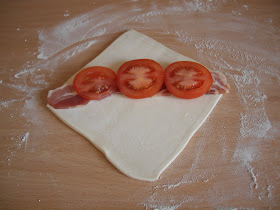
Slice your tomato and place on top of the bacon.

Place a chipolata sausage on top of the tomato slices.

Cover the ingredients with a generous helping of grated cheddar cheese.

Now fold the bottom corner over the ingredients.

Bring the top corner over the pastry bundle and wash lightly with a beaten egg.

Place in a pre-heated oven at 180c for 25 minutes or until golden brown before placing on a cooling rack to cool.
Here I have used bacon and sausage from the Devon Lop pig along with a local Cheddar cheese and home grown tomatoes.
In Somerset this version would have chopped apple in place of the tomato.
 Roll out a piece of puff pastry to approximately a 5" x 5" diamond shape.
Roll out a piece of puff pastry to approximately a 5" x 5" diamond shape. Place a rasher of rindless streaky bacon on the pastry from left to right.
Place a rasher of rindless streaky bacon on the pastry from left to right.
Slice your tomato and place on top of the bacon.

Place a chipolata sausage on top of the tomato slices.

Cover the ingredients with a generous helping of grated cheddar cheese.

Now fold the bottom corner over the ingredients.

Bring the top corner over the pastry bundle and wash lightly with a beaten egg.

Place in a pre-heated oven at 180c for 25 minutes or until golden brown before placing on a cooling rack to cool.
These delightful pastries will not get a chance to cool, as they will be eaten in minutes of coming out of the oven.
Saturday, 9 October 2010
Prosciutto di Anatra
Prosciutto di Anatra or Duck Ham to the likes of you and me, this has to be the easiest form of Italian charcuterie we can imagine to make.
Firstly take your duck and cut off the legs and place to one side for further use, perhaps for a French rillette or confit.
Now following the breast bone, cut away the two breasts.
Place the two breasts inside a ziplock bag and add 30g of ground sea salt per kilo of meat and for this dish add some grated zest of orange.
Here I have used a local sea salt after having first ground it down to a fine consistency, I then applied it to the duck breasts until all areas are covered.
Having left the breasts to cure in the fridge for 3 to 4 days turning daily, I then take them out of their bags and pat them dry with a paper towel and hang them to air dry for anything upto several weeks, depending on your own personal taste.
I do though, like to use my prosciutto as a carpaccio soon after curing, here I slice thinly and arrange on a plate before adding a small salad along with an orange garnish and an orange juice & olive oil dressing.
This refreshing dish is perfect to share at the table amongst friends, so please give this simple dish a place at your table.
Tip: The duck breasts could if you so wish be cooked in the convential way after the curing stage, here they would take on the flavour of duck bacon, truly scrumptious!
Firstly take your duck and cut off the legs and place to one side for further use, perhaps for a French rillette or confit.
Now following the breast bone, cut away the two breasts.
Place the two breasts inside a ziplock bag and add 30g of ground sea salt per kilo of meat and for this dish add some grated zest of orange.
Here I have used a local sea salt after having first ground it down to a fine consistency, I then applied it to the duck breasts until all areas are covered.
Having left the breasts to cure in the fridge for 3 to 4 days turning daily, I then take them out of their bags and pat them dry with a paper towel and hang them to air dry for anything upto several weeks, depending on your own personal taste.
I do though, like to use my prosciutto as a carpaccio soon after curing, here I slice thinly and arrange on a plate before adding a small salad along with an orange garnish and an orange juice & olive oil dressing.
This refreshing dish is perfect to share at the table amongst friends, so please give this simple dish a place at your table.
Tip: The duck breasts could if you so wish be cooked in the convential way after the curing stage, here they would take on the flavour of duck bacon, truly scrumptious!
Monday, 4 October 2010
Taste of Bute
The Sleeping Warrior sounds like a deceased Native Indian Chief from centuries past, who would know it is the local name given to one of the mountain ranges that can be seen from the Isle of Bute in the Highlands of Scotland.
My good friends Brian and Janet Hill, farm beef cattle and sheep on what has to be one of the most picturesque farmlands I have ever seen, right at the most southernly point of the Isle of Bute.
However beautiful a place may be, it usually means that it will also be remote and it will have challenges that we on the mainland neither face nor understand. The added costs of farming on such an Idyllic Island are vast, for example, in bad times transportation by ferry and road to an abattoir can outweigh any profit made from rearing such animals, in particular as you may have bought and brought winter cattle feed from the mainland in order to feed your animals in the first instance.

Diversification on Islands such as Bute, can often mean the difference between survival and failure. I had the good fortune last year to travel to the Scottish Highlands and whilst there I met Brian who attended one of my charcuterie courses. Brian grasped imediately the concept and went away and very quickly adapted a Merguez sausage recipe to create his own version, a local hot-smoked sausage with some kick and happily named it after the mountain range he views from his farm "The Sleeping Warrior".
So good is this sausage, actor Alex Norton from the television series "Taggart" fame, visited Plan Farm to see for himself how and where this sausage is produced. Alex's visit was covered by "The Hour" programme and was aired on Scottish Television.
Follow this link to view: http://player.stv.tv/programmes/the-hour/2010-09-28-1700/

I do hope you will visit their website www.tasteofbute.co.uk and see for yourself what both Brian and Janet are doing in order to diversify and survive in farming. They need your help, so please order your sample of the magnificent "Sleeping Warrior" today.
http://www.tasteofbute.co.uk/
My good friends Brian and Janet Hill, farm beef cattle and sheep on what has to be one of the most picturesque farmlands I have ever seen, right at the most southernly point of the Isle of Bute.
However beautiful a place may be, it usually means that it will also be remote and it will have challenges that we on the mainland neither face nor understand. The added costs of farming on such an Idyllic Island are vast, for example, in bad times transportation by ferry and road to an abattoir can outweigh any profit made from rearing such animals, in particular as you may have bought and brought winter cattle feed from the mainland in order to feed your animals in the first instance.

Diversification on Islands such as Bute, can often mean the difference between survival and failure. I had the good fortune last year to travel to the Scottish Highlands and whilst there I met Brian who attended one of my charcuterie courses. Brian grasped imediately the concept and went away and very quickly adapted a Merguez sausage recipe to create his own version, a local hot-smoked sausage with some kick and happily named it after the mountain range he views from his farm "The Sleeping Warrior".
So good is this sausage, actor Alex Norton from the television series "Taggart" fame, visited Plan Farm to see for himself how and where this sausage is produced. Alex's visit was covered by "The Hour" programme and was aired on Scottish Television.
Follow this link to view: http://player.stv.tv/programmes/the-hour/2010-09-28-1700/

I do hope you will visit their website www.tasteofbute.co.uk and see for yourself what both Brian and Janet are doing in order to diversify and survive in farming. They need your help, so please order your sample of the magnificent "Sleeping Warrior" today.
http://www.tasteofbute.co.uk/





